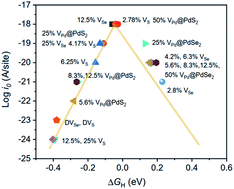Defect induced electrocatalytic hydrogen properties of pentagonal PdX2 (X = S, Se)†
Abstract
Searching for catalysts of hydrogen evolution reaction (HER) that can replace Pt is critical. Here, we investigated the HER electrocatalytic activity of pentagonal PdS2 (penta-PdS2) and PdSe2 (penta-PdSe2) by first-principles calculations. Three types of vacancies (VS/Se, VPd, DVS/Se) were constructed to activate the inert basal planes of PdS2 and PdSe2. The results show that S/Se and Pd vacancies significantly improve HER performance, and the Gibbs free energy (ΔGH) of systems can be further regulated by vacancy concentration. Particularly, PdS2 with 2.78% VS, 50% VPd and PdSe2 with 12.5% VSe display the optimal ΔGH value and the highest exchange current density. Further analysis of charge transfer and band structures were described that the introduce of vacancies efficiently regulates the electronic properties, resulting in the diminution of bandgap, and accelerates the charge transfer, thereby contributing to an enhanced electron environment for HER process. Our results provide a theoretical guidance for the applications of pentagonal transition-metal dichalcogenides as catalysts of hydrogen evolution reaction.



 Please wait while we load your content...
Please wait while we load your content...